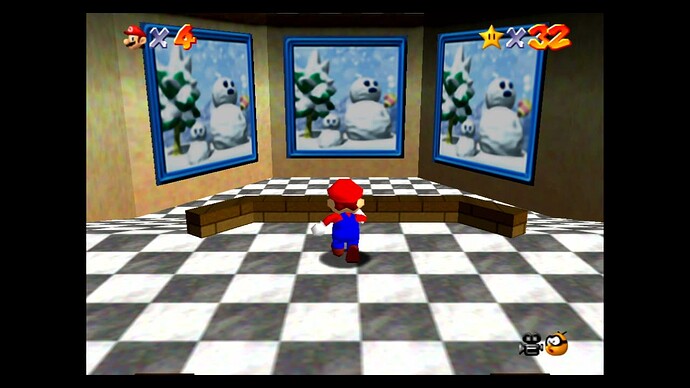“Gestures Toward Divinity” is a game that features the artwork of Francis Bacon but claims to be “not about him.” It is, in fact, a text adventure adaptation of Super Mario 64.
You get to enter several of Bowser’s Bacon’s paintings. You are a silent protagonist who engages in one-sided dialogue with mythical toads Furies and two versions of Bowser’s Bacon’s companion, Princess Peach George Dyer. Once you collect all of the stars conversation achievements, you get to fight Bowser meet exactly who you’d expect to meet.
I especially liked the triptych titled “Figures at the Base of Cool Cool Mountain”
In all seriousness, this is a conversational game that is almost entirely about Bacon’s artwork. By extension, it is largely not about Bacon himself: it’s mostly about his subjects and closest companions, and the issues that his art was concerned with.
The conversations are the strongest part of the game: they’re all very thoughtful, and two of them seem to be faithful to the one real-life individual portrayed (George Dyer) even if he is fictionalized.
Descriptions of each painting are pretty wordy, and they don’t really have the immediate visceral impact that Bacon’s paintings have. I don’t think the game would be better if it included images alongside the text, but it’s probably best if you are familiar with each painting before playing.
The title “Gestures Toward Divinity” points to the religious themes that Bacon touched on, as well as related topics such as violence, sexuality, retribution/karma, and an afterlife.
The game takes a largely humanistic view of these topics in line with Bacon’s, and I suppose Dyer’s atheism. However, there is the implication that the player character is in an afterlife — as they are wearing a white robe that they have never seen before in a gallery that they don’t know the location of. I briefly considered that I was playing as Dyer himself after dying, but I think it is implied that the player character is a woman and there is no indication that it is anyone in Bacon’s life.
Plus, the afterlife theory isn’t really backed up by the text elsewhere as far as I can tell, and tonally it is more like a dream or subdued nightmare. Maybe that was the author’s intention.
The achievement titles add some lightness to the tone of the game. So do the barista and guard characters, who have varying degrees of investment in the art itself.
2. Ending
The game’s ending, despite being the only ending, is ambiguous: you tell a self-portrait of Francis Bacon “who he is,” and he screams.
There are at least two possible explanations for this, since your half of the dialogue is not shown. Possibly, you tell the portrait that it is a portrait of Francis Bacon. The portrait knows about Francis Bacon’s legacy, and to its horror realizes that he is Bacon despite its attempts to suppress that fact. This is supported by the portrait’s apparent attempts to dissociate from itself by rambling about art.
Alternatively, you tell the portrait who Bacon has become. The portrait already knows that it is a portrait of Francis Bacon, but not about Bacon’s legacy. Dialogue with Dyer – “I hope it rots [Bacon] from the inside out until everyone who meets him can see exactly who he is.” — supports this latter interpretation, though it’s hard to be sure.
It should be noted that, in real life, Bacon’s self-portraits often involved him painting a warped version his face. As far as I know, these did not show him screaming. The fact that Bacon screams in the game seems to be a reference to Bacon’s screaming pope portrait, as described by the museum guard, and the Battleship Potemkin/Odessa Steps photo, which is displayed in one gallery room.
3. Implementation and Technical Issues
I did not find any serious technical/implementation issues. However, as a subjective design decision, the fact that each painting is a triptych seems underused in terms of interaction. The list of topics changes frequently, and it is unfortunate that these are condensed into a single “place” when they could have been broken up across three separate areas and arranged in a more structured way.
There were a few minor things that I definitely couldn’t get to work. I was unable to ask the barista “whether Bacon’s art freaks her out” out even when the game told me to do so. However, that option disappeared and I finally was able to earn the 120th star complete conversation achievement.
It also seemed that some topics weren’t removed from the conversation list after asking them, though it is possible that I was typing the required prompts wrong.
Finally, it is easy to miss the ending since the “tell Bacon who he is” suggestion does not appear immediately. I didn’t notice it until I read someone else’s review.
None of these issues made the game difficult to play, and I fully recommend it. The fact that the primary goal involves exhausting conversational topics means that it can be completed somewhat faster than the 2 hour play time estimate suggests.
Side note: For anyone who is interested in horror art and outsider art, I would recommend the YouTube channel Blind Dweller. The host has covered Bacon’s work and many other artists. I especially liked this one on Edvard Munch:
You’ll need to go elsewhere for coverage of the disturbing atmosphere of Super Mario 64’s Wet Dry World.

